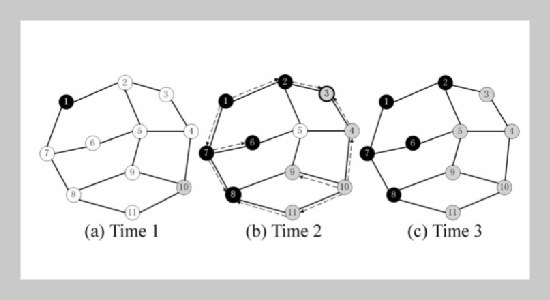REFERENCES
- [1] Fang, B. X., Online Social Network Analysis, Beijing: Publishing House of Electronics Industry (2014).
- [2] Myers, S. A. and Leskovec, J., “CLASH of the contagions: Cooperation and Competition in Information Diffusion. Data Mining (ICDM),” 2012 IEEE 12th International Conference on IEEE, pp. 539�548 (2012). doi: 10.1109/ICDM.2012.159
- [3] Wang, Y. Z., Yu, J. Y., Qu, W., Shen, H. W., Cheng, X. Q. and Lin, C., “Evolutionary Game Model and Analysis Methods for Network Group Behavior,” Chinese Journal of Computers, Vol. 38, No. 2, pp. 282�300 (2012).
- [4] Ten Kate, S., Haverkamp, S., Mahmood, F., et al., “Social Network Influences on Technology Acceptance: A Matter of Tie Strength, Centrality and Density,” BLED 2010 Proceedings, Paper, p. 40 (2010).
- [5] Scott, J., “Social Network Analysis: Developments, Advances, and Prospects,” Social Network Analysis and Mining, Vol. 1, No. 1, pp. 21�26 (2011). doi: 10.1007/s13278-010-0012-6
- [6] Pathak, N., Banerjee, A. and Srivastava, J., “A Generalized Linear Threshold Model for Multiple Cascades,” Data Mining (ICDM), 2010 IEEE 10th International Conference on IEEE, pp. 965�970 (2010). doi: 10. 1109/ICDM.2010.153
- [7] Prakash, B. A., Beutel, A., Rosenfeld, R., et al., “Winner Takes All: Competing Viruses or Ideas on Fairplay Networks,” Proceedings of the 21st International Conference on WORLD Wide Web, ACM, pp. 1037� 1046 (2012). doi: 10.1145/2187836.2187975
- [8] Weng, L., Flammini, A., Vespignani, A., et al., “Competition among Memes in a World with Limited Attention,” Nature: Scientific Reports, Vol. 2, No. 7391, pp. 1�8 (2012). doi: 10.1038/srep02304
- [9] Iribarren, J. L. and Moro, E., “Impact of Human Activity Patterns on the Dynamics of Information Diffusion,” Physical Review Letters, Vol. 103, No. 3 (2009). doi: 10.1103/PhysRevLett.103.038702
- [10] Jiang, Y. and Jiang, J., “Diffusion in Social Networks: A Multiagent Perspective,” IEEE Transactions on Systems, Man, and Cybernetics: Systems, Vol. 45, No. 2, pp. 198�213 (2015). doi: 10.1109/TSMC.2014.2339198
- [11] Jiang, Y. and Jiang, J., “Understanding Social Networks from a Multiagent Perspective,” IEEE Transactions on Parallel and Distributed Systems, Vol. 25, No. 10, pp. 2743�2759 (2014). doi: 10.1109/TPDS.2013. 254
- [12] Gao, C., Liu, J. and Zhong, N., “Network Immunization with Distributed Autonomy-oriented Entities,” IEEE Transactions on Parallel and Distributed Systems, Vol. 22, No. 7, pp. 1222�1229 (2011). doi: 10.1109/TPDS.2010.197
- [13] Kempe, D., Kleinberg, J. and Tardos, É., “Maximizing the Spread of Influence through a Social Network,” Proceedings of the Ninth ACM SIGKDD International Conference on Knowledge Discovery and Data Mining, ACM, pp. 137�146 (2003). doi: 10.1145/956755. 956769
- [14] Domingos, P. and Richardson, M., “Mining the Network Value of Customers,” Proceedings of the Seventh ACM SIGKDD International Conference on Knowledge Discovery and Data Mining, ACM, pp. 57�66 (2001). doi: 10.1145/502512.502525
- [15] Richardson, M. and Domingos, P., “Mining Knowledge-sharing Sites for Viral Marketing,” Proceedings of the Eighth ACM SIGKDD International Conference on Knowledge Discovery and Data Mining, ACM, pp. 61�70 (2002). doi: 10.1145/775056.775057
- [16] Kostka, J., Oswald, Y. A. and Wattenhofer, R., “Word of Mouth: Rumor Dissemination in Social Networks,” Proc. 15th Intl. Colloquium on Structural Information and Communication Complexity, Springer Berlin Heidelberg, pp. 185�196 (2008). doi: 10.1007/978-3- 540-69355-0_16
- [17] Zinoviev, D. and Duong, V., “A Game Theoretical Approach to Broadcast Information Diffusion in Social Networks,” Proceedings of the 44th Annual Simulation Symposium, Society for Computer Simulation International, pp. 47�52 (2011).
- [18] Zinoviev, D., Duong, V. and Zhang, H., “A Game Theoretical Approach to Modeling Information Dissemination in Social Networks,” arXiv Preprint Computer Science and Game Theory, Vol. I, pp. 407�412 (2010).
- [19] Yu, J., Wang, Y., Li, J., et al., “Analysis of Competitive Information Dissemination in Social Network Based on Evolutionary Game Model,” Cloud and Green Computing (CGC), 2012 Second International Conference on IEEE, pp. 748�753 (2012). doi: 10.1109/ CGC.2012.126
- [20] Yu, J., Wang, Y., Jin, X., et al., “Social Evolutionary Games,” Game Theory for Networks (GAMENETS), 2014 5th International Conference on IEEE, pp. 1�5 (2014). doi: 10.1109/GAMENETS.2014.7043726
- [21] Saberi, A. and Montanari, A., “The Spread of Innovations in Social Networks,” Proceedings of the National Academy of Sciences, Vol. 107, No. 47, pp. 20196� 20201 (2010). doi: 10.1073/pnas.1004098107
- [22] Tomassini, M. and Pestelacci, E., “Coordination Games on Dynamical Networks,” Games, Vol. 1 No. 3, pp. 242�261 (2010). doi: 10.3390/g1030242
- [23] Fu, F., Hauert, C., Nowak, M. A., et al., “Reputationbased Partner Choice Promotes Cooperation in Social Networks,” Physical Review E, Vol. 78, No. 2, pp. 026117 (2008). doi: 10.1103/PhysRevE.78.026117
- [24] Santos, F. C., Pacheco, J. M. and Lenaerts, T., “Cooperation Prevails When Individuals Adjust Their Social Ties,” PLoS Comput Biol, Vol. 2, No. 10, pp. 1284�1291 (2006). doi: 10.1371/journal.pcbi.0020140
- [25] Szabó, G. and Tke, C., “Evolutionary Prisoner’s Dilemma Game on a Square Lattice,” Physical Review E, Vol. 58, No. 1, pp. 69�73 (1998). doi: 10.1103/Phys RevE.58.69









